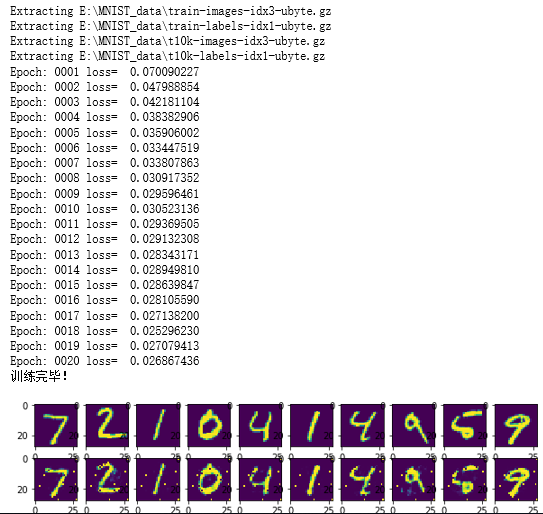吴裕雄 PYTHON 神经网络——TENSORFLOW 单隐藏层自编码器设计处理MNIST手写数字数据集并使用TensorBord描绘神经网络数据
import os
import numpy as np
import tensorflow as tf
import matplotlib.pyplot as plt
from tensorflow.examples.tutorials.mnist import input_data os.environ['TF_CPP_MIN_LOG_LEVEL'] = '' learning_rate = 0.01 # 学习率
training_epochs = 20 # 训练轮数,1轮等于n_samples/batch_size
batch_size = 128 # batch容量
display_step = 1 # 展示间隔
example_to_show = 10 # 展示图像数目 n_hidden_units = 256
n_input_units = 784
n_output_units = n_input_units def WeightsVariable(n_in, n_out, name_str):
return tf.Variable(tf.random_normal([n_in, n_out]), dtype=tf.float32, name=name_str) def biasesVariable(n_out, name_str):
return tf.Variable(tf.random_normal([n_out]), dtype=tf.float32, name=name_str) def encoder(x_origin, activate_func=tf.nn.sigmoid):
with tf.name_scope('Layer'):
Weights = WeightsVariable(n_input_units, n_hidden_units, 'Weights')
biases = biasesVariable(n_hidden_units, 'biases')
x_code = activate_func(tf.add(tf.matmul(x_origin, Weights), biases))
return x_code def decode(x_code, activate_func=tf.nn.sigmoid):
with tf.name_scope('Layer'):
Weights = WeightsVariable(n_hidden_units, n_output_units, 'Weights')
biases = biasesVariable(n_output_units, 'biases')
x_decode = activate_func(tf.add(tf.matmul(x_code, Weights), biases))
return x_decode with tf.Graph().as_default():
with tf.name_scope('Input'):
X_input = tf.placeholder(tf.float32, [None, n_input_units])
with tf.name_scope('Encode'):
X_code = encoder(X_input)
with tf.name_scope('decode'):
X_decode = decode(X_code)
with tf.name_scope('loss'):
loss = tf.reduce_mean(tf.pow(X_input - X_decode, 2))
with tf.name_scope('train'):
Optimizer = tf.train.RMSPropOptimizer(learning_rate)
train = Optimizer.minimize(loss) init = tf.global_variables_initializer()
writer = tf.summary.FileWriter(logdir='logs', graph=tf.get_default_graph())
writer.flush() learning_rate = 0.01 # 学习率
training_epochs = 20 # 训练轮数,1轮等于n_samples/batch_size
batch_size = 128 # batch容量
display_step = 1 # 展示间隔
example_to_show = 10 # 展示图像数目 n_hidden_units = 256
n_input_units = 784
n_output_units = n_input_units def WeightsVariable(n_in, n_out, name_str):
return tf.Variable(tf.random_normal([n_in, n_out]), dtype=tf.float32, name=name_str) def biasesVariable(n_out, name_str):
return tf.Variable(tf.random_normal([n_out]), dtype=tf.float32, name=name_str) def encoder(x_origin, activate_func=tf.nn.sigmoid):
with tf.name_scope('Layer'):
Weights = WeightsVariable(n_input_units, n_hidden_units, 'Weights')
biases = biasesVariable(n_hidden_units, 'biases')
x_code = activate_func(tf.add(tf.matmul(x_origin, Weights), biases))
return x_code def decode(x_code, activate_func=tf.nn.sigmoid):
with tf.name_scope('Layer'):
Weights = WeightsVariable(n_hidden_units, n_output_units, 'Weights')
biases = biasesVariable(n_output_units, 'biases')
x_decode = activate_func(tf.add(tf.matmul(x_code, Weights), biases))
return x_decode with tf.Graph().as_default():
with tf.name_scope('Input'):
X_input = tf.placeholder(tf.float32, [None, n_input_units])
with tf.name_scope('Encode'):
X_code = encoder(X_input)
with tf.name_scope('decode'):
X_decode = decode(X_code)
with tf.name_scope('loss'):
loss = tf.reduce_mean(tf.pow(X_input - X_decode, 2))
with tf.name_scope('train'):
Optimizer = tf.train.RMSPropOptimizer(learning_rate)
train = Optimizer.minimize(loss)
init = tf.global_variables_initializer() writer = tf.summary.FileWriter(logdir='E:\\tensorboard\\logs', graph=tf.get_default_graph())
writer.flush() mnist = input_data.read_data_sets("E:\\MNIST_data\\", one_hot=True) with tf.Session() as sess:
sess.run(init)
total_batch = int(mnist.train.num_examples / batch_size)
for epoch in range(training_epochs):
for i in range(total_batch):
batch_xs, batch_ys = mnist.train.next_batch(batch_size)
_, Loss = sess.run([train, loss], feed_dict={X_input: batch_xs})
Loss = sess.run(loss, feed_dict={X_input: batch_xs})
if epoch % display_step == 0:
print('Epoch: %04d' % (epoch + 1), 'loss= ', '{:.9f}'.format(Loss))
writer.close()
print('训练完毕!') '''比较输入和输出的图像'''
# 输出图像获取
reconstructions = sess.run(X_decode, feed_dict={X_input: mnist.test.images[:example_to_show]})
# 画布建立
f, a = plt.subplots(2, 10, figsize=(10, 2))
for i in range(example_to_show):
a[0][i].imshow(np.reshape(mnist.test.images[i], (28, 28)))
a[1][i].imshow(np.reshape(reconstructions[i], (28, 28)))
f.show() # 渲染图像
plt.draw() # 刷新图像
# plt.waitforbuttonpress()


吴裕雄 PYTHON 神经网络——TENSORFLOW 单隐藏层自编码器设计处理MNIST手写数字数据集并使用TensorBord描绘神经网络数据的更多相关文章
- 吴裕雄 PYTHON 神经网络——TENSORFLOW 双隐藏层自编码器设计处理MNIST手写数字数据集并使用TENSORBORD描绘神经网络数据2
import os import tensorflow as tf from tensorflow.examples.tutorials.mnist import input_data os.envi ...
- Android+TensorFlow+CNN+MNIST 手写数字识别实现
Android+TensorFlow+CNN+MNIST 手写数字识别实现 SkySeraph 2018 Email:skyseraph00#163.com 更多精彩请直接访问SkySeraph个人站 ...
- 基于tensorflow的MNIST手写数字识别(二)--入门篇
http://www.jianshu.com/p/4195577585e6 基于tensorflow的MNIST手写字识别(一)--白话卷积神经网络模型 基于tensorflow的MNIST手写数字识 ...
- TensorFlow——MNIST手写数字识别
MNIST手写数字识别 MNIST数据集介绍和下载:http://yann.lecun.com/exdb/mnist/ 一.数据集介绍: MNIST是一个入门级的计算机视觉数据集 下载下来的数据集 ...
- Tensorflow实现MNIST手写数字识别
之前我们讲了神经网络的起源.单层神经网络.多层神经网络的搭建过程.搭建时要注意到的具体问题.以及解决这些问题的具体方法.本文将通过一个经典的案例:MNIST手写数字识别,以代码的形式来为大家梳理一遍神 ...
- mnist手写数字识别——深度学习入门项目(tensorflow+keras+Sequential模型)
前言 今天记录一下深度学习的另外一个入门项目——<mnist数据集手写数字识别>,这是一个入门必备的学习案例,主要使用了tensorflow下的keras网络结构的Sequential模型 ...
- 用tensorflow搭建RNN(LSTM)进行MNIST 手写数字辨识
用tensorflow搭建RNN(LSTM)进行MNIST 手写数字辨识 循环神经网络RNN相比传统的神经网络在处理序列化数据时更有优势,因为RNN能够将加入上(下)文信息进行考虑.一个简单的RNN如 ...
- Tensorflow可视化MNIST手写数字训练
简述] 我们在学习编程语言时,往往第一个程序就是打印“Hello World”,那么对于人工智能学习系统平台来说,他的“Hello World”小程序就是MNIST手写数字训练了.MNIST是一个手写 ...
- 基于TensorFlow的MNIST手写数字识别-初级
一:MNIST数据集 下载地址 MNIST是一个包含很多手写数字图片的数据集,一共4个二进制压缩文件 分别是test set images,test set labels,training se ...
随机推荐
- js中迭代方法
基础遍历数组: for() for( in ) for(var i = 0;i<arr.length;i++){ ...
- 用Object.prototype.toString.call(obj)检测对象类型原因分析
用Object.prototype.toString.call(obj)检测对象类型原因分析 更新时间:2018年10月11日 08:46:33 投稿:laozhang 我要评论 在本 ...
- centos7解压压缩zip文件
一.安装支持ZIP的工具 yum install -y unzip zip 二.解压zip文件 unzip 文件名.zip 二. 压缩一个zip文件 zip 文件名.zip 文件夹名称或文件名称
- ASPxDashboardViewer_OnDashboardLoaded 修改Item参数
protected void ASPxDashboardViewer_OnDashboardLoaded(object sender, DashboardLoadedWebEventArgs e) { ...
- 利用python装饰器为字符串添加,HTML标签
# 为字符串添加HTML标签 import time def zhuang(fun): def zhaung_1(*args, **kargs): # time.sleep(1) html_str = ...
- 你是否听说过 HashMap 在多线程环境下操作可能会导致程序死循环?
作者:炸鸡可乐 原文出处:www.pzblog.cn 一.问题描述 经常有些面试官会问,是否了解过 HashMap 在多线程环境下使用时可能会发生死循环,导致服务器 cpu 100% 的线上故障? 关 ...
- Contos7下安装Redis
第一步:在线下载Redis的安装包 cd /opt/ wget http://download.redis.io/releases/redis-5.0.2.tar.gz `ps:也可自行下载到本地,让 ...
- vs2008编译错误fatal error C1902: 程序数据库管理器不匹配;请检查安装解决
重装了本本上的Xp系统,如往常一样,升级,装杀毒软件,开发工具.一些进行的非常顺利.然而,在我打开VS2008准备耕作的时候,尽然出现了一邪恶的错误提示:vs2008编译错误fatal error C ...
- ASP.NET MVC扩充数据模型-定义数据模型的Metadata
ASP.NET MVC扩充数据模型-定义数据模型的Metadata Posted on 2018-07-12 by Wang Kepai Rate this post 无论你是使用LINQ t ...
- DisplayNameFor()方法的工作原理
DisplayNameFor()方法的工作原理原创Peter Yelnav 最后发布于2018-11-23 11:09:51 阅读数 1308 收藏展开最近研究了一下ASP.NET MVC,困惑于视图 ...
